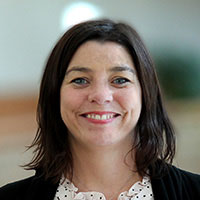How To Build A Lab
Investing in the sciences to aid "the least of these"
Inside the labyrinthine halls of the Baylor Sciences Building reside more than 150 laboratories. One lab is the research home of Dr. Kelli Barr, assistant professor of biology and tropical disease biologist. She joined the Baylor faculty in 2018 after serving as a research assistant professor at the University of Florida’s College of Veterinary Medicine.
Barr brought with her to Baylor a passion to heal the world’s poorest billion people through her work in virology.
“If it’s a virus and an insect spreads it,” she said, “I study it.”
For most people, the work that goes on in scientific laboratories can be nebulous, and the equipment therein more so. As Baylor moves more deeply into Illuminate and invests in research that addresses societal problems while advancing the University toward R1/Tier 1 research recognition, the breakthroughs that take place inside these labs will shine more brightly than ever.
Building a lab and conducting meaningful research is a process that requires planning and support. Step inside Barr’s lab to learn more about why and how Baylor invests in such work — and the scholarship, mentorship and dedication that make it possible.
UNDER THE MICROSCOPE
“My lab exists to help people avoid sickness from vector-borne diseases. I’m a virologist, and I work alongside my students to understand how infection with viruses such as West Nile, Zika or Dengue can cause chronic neurodegeneration. I am specifically interested in encephalitic and hemorrhagic viruses, and study how these viruses cause disease within cells or tissue types.
“Right now, my students and I are working on three projects: growing placental cells to study how a virus can cross the placenta to infect a developing fetus; studying the impact of viruses on the brain; and quantifying viruses across different specimens through the study of kidney cells. Four undergraduate students and three graduate students worked with me in the fall semester, and the work they do rivals what I’ve seen from doctoral students at other institutions.”
SETTING UP A LAB
“When you move to a new university, it often takes well over a year to get your lab set up, to get your students in, to get everything running to where you can publish papers. [In less than a year at Baylor] we’re already writing and publishing papers.
“There are a lot of regulatory procedures to go through when starting a lab — compliance and construction, for example. In this lab, the airflow system has to maintain a specific negative airflow pressure requiring constant air changes. We had to reconfigure the ventilation system, which can take time. Baylor was very supportive and it happened quickly.”
INCUBATORS
“The incubators next to the safety cabinet, are humidified, temperature-controlled chambers that allow us to grow viruses in organoids and in tissues in a controlled environment — sterile and rubber-gasket sealed. Nothing can get out. They keep us safe.”
BIOSAFETY CABINET
“The most important tool in this lab is the biosafety cabinet. It creates a sterile environment for us to work with viruses. The viruses can’t get out to make us sick, and nothing from the environment gets in to contaminate our work. Most of our work, 80 percent to 90 percent, is conducted in these biosafety cabinets.
“A vent creates a curtain of air, flowing through at a specific velocity preventing, particles from moving back and forth. You have to keep your hands in far enough past that curtain, and you can’t move too quickly or you can compromise the curtain of air.”
MISSIONAL SIDE OF TROPICAL DISEASE MEDICINE
“These diseases affect the developing regions of the world. In affluent nations like ours, we don’t have the problems and burdens of tropical disease found in other parts of the world. The common denominator we all share is simply trying to keep people alive and healthy. There’s nothing worse than watching a child in a hospital bed bleed to death because he was bitten by a bug. There’s nothing worse than going through a hospital ward knowing that half the people are going to get encephalitis from malaria because they were diagnosed too late and the malaria they have is drug resistant. To know that these diseases are preventable by addressing insect control and water quality — vaccines and medicines aside. We just want to help people
live better.
“You have to have that mission in your heart, if you’re going to do tropical disease research. You’re not in it for monetary or material gain. You will gain friends, you will get to give, you will feel like you’ve helped someone. It’s more of a service than a profession. I think the students here share that mentality. They want to serve. They’re legitimately trying to help people.”
SAFETY AND STUDENT TRAINING
“We take many precautions working here, knowing that my major workforce is undergraduate researchers. Most of the viruses I have in here are vaccine strains. If there’s a spill or an accident, you just vaccinate yourself. The other strains I use have been lab adapted, which means they’ve been attenuated and weakened. So, even if you did splash yourself in the face, you probably wouldn’t get sick.
“I provide students with pathogen-specific training every year which involves several hours of biosafety training with environmental health and safety. Then they are allowed to choose whether or not they want to work with the pathogenic strains.
“It takes a semester to train students, about 50 to 90 contact hours side-by-side with me in the biosafety cabinet or under the microscope.”
